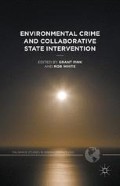Abstract
Port-to-port collaboration is essential to enable countries to detect and deter illegal shipments of hazardous and electronic waste. This cooperation is broadly defined in the seaport environmental security context. Enforcement cooperation activities can be any type of formal or informal exchange of information or expertise on environmental compliance and enforcement related matters. Effective enforcement can help create a level playing field for regulated industries domestically and internationally, resolve and prevent transboundary environmental problems, create efficiencies in the development of tools and programmes, and foster the political will needed to strengthen implementation of environmental standards (INECE, 2011).
The views expressed herein are those of the authors and do not represent the views of the Netherlands Human Environment and Transport Inspectorate (ILENT), United States Environment Protection Agency, or International Network for Environmental Compliance and Enforcement (INECE).
Access this chapter
Tax calculation will be finalised at checkout
Purchases are for personal use only
Preview
Unable to display preview. Download preview PDF.
References
Akella, A.S. and Cannon, J.B. (2004), Strengthening the Weakest Links: Strategies for Improving the Enforcement of Environmental Laws Globally. Washington, DC: Center for Conservation and Governance, Conservation International.
CEC (2013), Hazardous Trade? An Examination of US-generated Spent Lead-acid Battery Exports and Secondary Lead Recycling in Canada, Mexico, and the US. Available at http://www.cec.org/Page.asp?PageID=751&SiteNodeID=1075 (accessed 21 January 2015).
Dill, D. and Kopsick, D. (2014), ‘Improving Cooperation between Customs and Environmental Agencies: Approaches to Working Together at Seaports to Prevent Illegal Transboundary Shipments of Hazardous Waste’, World Customs Journal, 8(2), September. Available at http://www.worldcustomsjournal.org/ (accessed 21 January 2015).
Duan, H., Miller, T.R., Gregory, J., and Kirchain, R. (2013), Quantitative Characterization of Domestic and Transboundary Flows of Used Electronics: Analysis of Generation, Collection, and Export in the United States. Available at http://step-initiative.org/tl_files/step/_documents/MIT-NCER%20US%20Used%20 Electronics%20Flows%20Report%20-%20December%202013.pdf (accessed 8 March 2014).
Europol (2013), Threat Assessment: Environmental Crime in the EU. Available at https://www.europol.europa.eu/sites/default/files/publications/4aenvironmental_crime_threatassessment_2013_-_public_version.pdf (accessed 20 January 2015).
FAS (2000), International Crime Threat Assessment (December). Available at https://www.fas.org/irp/threat/pub45270chap2.html#6 (accessed 20 January 2015).
The Guardian (2013), ‘Toxic ‘E-waste’ Dumped in Poor Nations, Says United Nations’, 14 December. Available at http://www.theguardian.com/global-development/2013/dec/14/toxic-ewaste-illegal-dumping-developing-countries (accessed 20 January 2015).
Heiss, R. (2011), ‘Illegal Exports of Hazardous Waste and Used Electronic Products: Enhancing Collaborative Enforcement with Customs’, in Proceedings of the 9th International Conference on Environmental Compliance and Enforcement, INECE Secretariat. Available at http://inece.org/conference/9/proceedings/24_Heiss. pdf (accessed 21 January 2015).
ILO (2012), The Global Impact of E-waste: Addressing the Challenge. Available at http://www.ilo.org/wcmsp5/groups/public/---ed_dialogue/---sector/documents/publication/wcms_196105.pdf (accessed 8 March 2014).
INECE (2011), ‘Whistler Statement’, in Proceedings of the 8th International Conference on Environmental Compliance and Enforcement, 5–11 April, Cape Town, South Africa. London: Cameron May, pp. 3–8. Available at http://inece.org/conference/9/WhistlerStatement.pdf (accessed 21 January 2015).
INECE (2012), Second International Hazardous Waste Inspection Project: Results and Recommendations. Available at http://inece.org/resource/sesn-report/ (accessed 21 January 2015).
INTERPOL (2013), Press Release: INTERPOL Operation Targets Illegal Trade of E-waste in Europe, Africa (25 February). Available at http://www.interpol.int/News-and-media/News/2013/N20130225 (accessed 20 January 2015).
Isarin, N. (2008), ‘Inspection and enforcement of hazardous waste and goods: Fostering international cross-border collaboration by the inauguration of a seaport network’, in Proceedings of the 8th International Conference on Environmental Compliance and Enforcement, 5–11 April, Cape Town, South Africa. London: Cameron May, pp. 391–396.
Kopsick, D. (2011), ‘Requirements for Effective Seaport Environmental Security: Collective Action at the Ports’, in Proceedings of the 9th International Conference on Environmental Compliance and Enforcement, 20–24 June, International Network for Environmental Compliance and Enforcement (INECE), British Columbia, Canada. Washington: INECE, pp. 222–229. Available at http://inece.org/conference/9/proceedings/29_Kopsick.pdf (accessed 21 January 2015).
Spapens, T. (2011), ‘Cross-Border Police Cooperation in Tackling Environmental Crime’, in Proceedings of the 9th International Conference on Environmental Compliance and Enforcement, INECE Secretariat. Available at http://www.inece.org/conference/9/papers/Spapens%20Paper_Netherlands_Final.pdf (accessed 21 January 2015).
UNEP (2012), Vital Waste Graphics 3. Available at http://www.grida.no/publica-tions/vg/waste3/ (accessed 9 March 2014).
VOA (Voice of America) (2006), Ivory Coast Government Panel Releases Toxic Waste Findings. Available at http://www.voanews.com/content/a-13-2006-11-23-voa22/319097.html (accessed 30 January 2015).
Editor information
Editors and Affiliations
Copyright information
© 2016 Henk Ruessink, Deborah Kopsick, Robert Heiss, and Meredith R. Koparova
About this chapter
Cite this chapter
Ruessink, H., Kopsick, D., Heiss, R., Koparova, M.R. (2016). Port-to-Port Collaboration. In: Pink, G., White, R. (eds) Environmental Crime and Collaborative State Intervention. Palgrave Studies in Green Criminology. Palgrave Macmillan, London. https://doi.org/10.1007/978-1-137-56257-9_9
Download citation
DOI: https://doi.org/10.1007/978-1-137-56257-9_9
Publisher Name: Palgrave Macmillan, London
Print ISBN: 978-1-349-55981-7
Online ISBN: 978-1-137-56257-9
eBook Packages: Earth and Environmental ScienceEarth and Environmental Science (R0)

